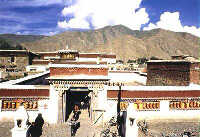|
Changzhu Monastery
( 2005-10-27 )
 Built during Tubo King Songtsen Gampo period in the 7th century, theChangzhu Monasteryis situated at the east bank of the Yalong River in the south of the Shannan Prefecture in Southwest China's Tibet Autonomous Region. It is Tibet's oldest Buddha worship hall, with a history of over 1,300 years. Built during Tubo King Songtsen Gampo period in the 7th century, theChangzhu Monasteryis situated at the east bank of the Yalong River in the south of the Shannan Prefecture in Southwest China's Tibet Autonomous Region. It is Tibet's oldest Buddha worship hall, with a history of over 1,300 years.
It is said that Princess Wencheng of theTang Dynasty(618-907) once lived there when she first entered Tibet. And also, there was once a famous hanging bell made under the supervision of Han monk Master Renqing in the late 8th century, containing 12 sentences of Tibetan epigraphs that were praised by the Tibetan people at that time.
In Tibetan, "Chang" means a big roc bird and "Zhu" meansdragon, so the Changzhu Monastery means the honorable monastery.
Tibetan legend goes that, once upon a time, the site of the monastery was an extremely deep lake. In the lake there is a five-head dragon. After Songtsen Gampo got control of Tibet, he wanted to drain the lake and build a castle there. So he invited two Buddhist masters to lure a big roc bird to attack the dragon.
The two masters first imitated the sound of the bird and lured the dragon out; then they imitated the sound of the dragon to lure the bird out. Next, the dragon and the bird began to fight. The bird at last chopped off two of the dragon's heads with its wings. Seven days later, the lake disappeared. That is how the monastery got its name.
Its main constructions include the Coqen Hall enshrining the statues of Songtsen Gampo, Sakyamuni, and Guanyin Bodhisattva, and a winding corridor with many scriptures carved on the wall. The hall on the second floor of the Coqen Hall enshrines the statue of Indian Master Padmasambhava.
The Coqen Hall still boasts a lot of statues andmural paintings in the hall. The most attractive is the Pearl-made Tangkha (a kind of embroidery), made of 29,026 pearls, 1 diamond, 1 ruby, 1 sapphire, and 15 grams of gold. It is a miracle to see it have passed down from generation to generation without being damaged or lost during political struggles and wars.
The Changzhu Monastery, which has experienced much damage, often fell into longtime disrepair during its existence. During the period of the 5th Dalai, the Changzhu Monastery was once repaired with the addition of a golden top for grandeur and respect to King Songtsen Gampo and Princess Wencheng. During the reign of the 13th Dalai Lama, it was repaired, enlarged, and renovated again.
In 1961, theState Councillisted the Changzhu Monastery as a key relic under state protection.
|

